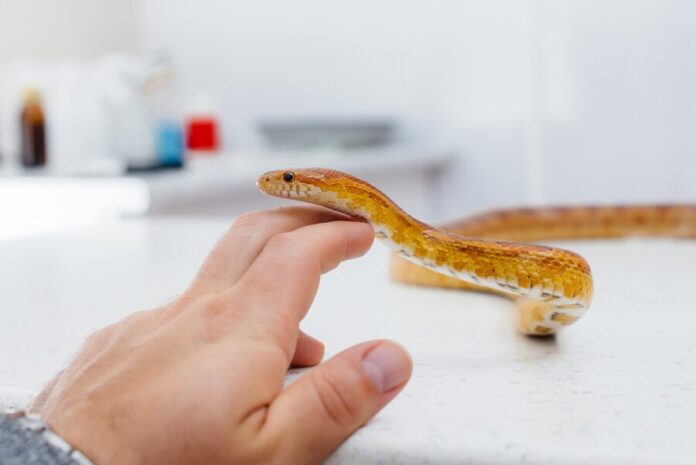When it comes to unique and fascinating pets, snakes are often at the top of the list for reptile enthusiasts and animal lovers. However, proper care is essential for keeping your pet snake healthy, happy, and thriving. Whether you’re a new pet snake owner or looking to improve your reptile care game, understanding the key elements of snake husbandry can make all the difference.
This guide will walk you through everything you need to know about pet snake care, from creating the perfect enclosure to feeding, handling, and ensuring your snake stays healthy. By the end, you’ll have all the tools you need to provide an exceptional life for your scaly companion.
Choosing the Right Enclosure
The Ideal Enclosure for Your Snake
One of the first and most important steps in pet snake care is choosing the right enclosure. Snakes require habitats that mimic their natural environments to stay comfortable and stress-free. The size and type of enclosure depend largely on the species of snake you own:
- Small snakes (e.g., Corn Snakes, King Snakes): A 20-40 gallon terrarium is typically sufficient.
- Medium snakes (e.g., Ball Pythons, Milk Snakes): Consider enclosures between 50-75 gallons.
- Large snakes (e.g., Boa Constrictors, Burmese Pythons): Larger enclosures of 100 gallons or more are necessary.
Ensure the enclosure has a secure, escape-proof lid or doors. Snakes are excellent escape artists and can slip through even the smallest gaps.
Creating a Comfortable Habitat
Your snake’s enclosure should include key elements to make it a welcoming and suitable home:
- Substrate: Use materials like aspen shavings, reptile carpet, or cypress mulch. Avoid substrates like pine or cedar, which can be toxic.
- Hides: Provide at least two hides—one on the warm side and one on the cool side of the enclosure—to give your snake a safe place to retreat.
- Climbing Structures (if applicable): Arboreal snake species like tree pythons will appreciate branches or vines to climb.
- Water Dish: Always include a large, shallow water dish for hydration and occasional soaking.
Temperature and Humidity Management
Why Temperature and Humidity Matter
Snakes are ectothermic animals, meaning they rely on external heat sources to regulate their body temperature. Maintaining the correct temperature and humidity levels is crucial for their health and well-being.
Temperature Guidelines
Provide a temperature gradient in your snake’s enclosure:
- Warm Side (Basking Area): This should range between 80-90°F, depending on the species. For tropical snakes like Ball Pythons, aim for the higher end.
- Cool Side: Maintain a cooler area around 75-80°F to allow your snake to regulate its body temperature.
- Nighttime Temperature: Make sure it doesn’t drop below 70°F.
Use equipment like heat lamps, ceramic heaters, or under-tank heating pads to achieve these conditions. Always monitor temperatures with reliable thermometers placed on both ends of the enclosure.
Humidity Levels
Different snake species have varying humidity needs. For instance:
- Tropical snakes (e.g., Boas, Pythons): 50-70% humidity.
- Desert snakes (e.g., Corn Snakes, Kingsnakes): 30-50% humidity.
Use a hygrometer to keep track of humidity levels, and adjust by misting the enclosure or using a humidifier if necessary.
Feeding Your Pet Snake
Dietary Needs by Species
The diet of your snake largely depends on its species, size, and age. Generally speaking:

- Small snakes: Mice are a common staple.
- Larger snakes: May require rats, chicks, or even rabbits.
- Specialized feeders: Some snakes, like garter snakes, may eat fish or amphibians.
Feeding Schedule
- Young snakes: Feed once every 5-7 days.
- Adult snakes: Feed every 10-14 days.
- Large snakes: May only require feeding every 3-4 weeks.
Avoid overfeeding, as obesity is a common issue in captive snakes.
Live vs. Frozen Prey
Many snake owners face the live vs. frozen debate. While live prey can stimulate natural hunting behaviors, it poses risks like injury to your snake. Frozen-thawed prey is safer and just as nutritious. Always thaw prey completely before offering it to your snake.
Handling and Socialization
Proper Handling Techniques
Handling is part of the bonding experience with your pet snake, but it should always be done with care:
- Approach your snake gently and avoid sudden movements.
- Support its body with both hands.
- Never handle a snake right after feeding to avoid stress or regurgitation.
Building Trust
Over time, regular but brief handling sessions can help your snake feel more comfortable around you. Pay attention to signs of stress, such as hissing, striking, or rapid tongue flicking, and give your snake space if it seems agitated.
Health and Hygiene
Common Health Issues
Pet snakes are susceptible to certain health problems, including:
- Mites: Can cause irritation and lead to anemia if untreated.
- Respiratory infections: Often caused by incorrect temperature or humidity levels.
- Shedding problems: Retained skin or eye caps indicate a lack of proper humidity.
If you notice signs of illness—like wheezing, lethargy, or loss of appetite—consult a reptile vet promptly.
Keeping the Enclosure Clean
A clean environment is essential for preventing health issues. Follow these tips:
- Spot clean daily to remove feces and uneaten food.
- Deep clean the enclosure and replace the substrate every 4-6 weeks.
- Disinfect the water dish and hides regularly with reptile-safe cleaners.
Empower Yourself as a Snake Owner
Owning and caring for a pet snake can be a rewarding experience, provided you meet their unique needs. From choosing the perfect enclosure and maintaining optimal temperature to understanding feeding habits and prioritizing their health, small adjustments can have a big impact on their quality of life.
Got your own tips for pet snake care? Share them in the comments below! And if you’re eager to learn more about reptile care, check out additional articles on our website for expert advice.


